The Relationship Between Fear and Alcohol Overconsumption: A Study
VerifiedAdded on 2023/03/20
|9
|2736
|24
Report
AI Summary
This report presents a study investigating the fear associated with the overconsumption of alcohol in Australia. Conducted through an online survey with 500 participants aged 18-44, the research aimed to determine the predictive value of fear in relation to alcohol consumption. The study examined the influence of factors like fear of health loss, social loss, and disgust on drinking intentions, using multiple regression analysis and various message framing conditions. The findings suggest that fear significantly impacts alcohol consumption habits, aligning with the alternative hypothesis. The study also highlights limitations such as time constraints and sample size, while offering insights into the interplay between psychological factors and alcohol consumption behaviors, suggesting that health consciousness and fear of social repercussions can be deterrents to excessive drinking.
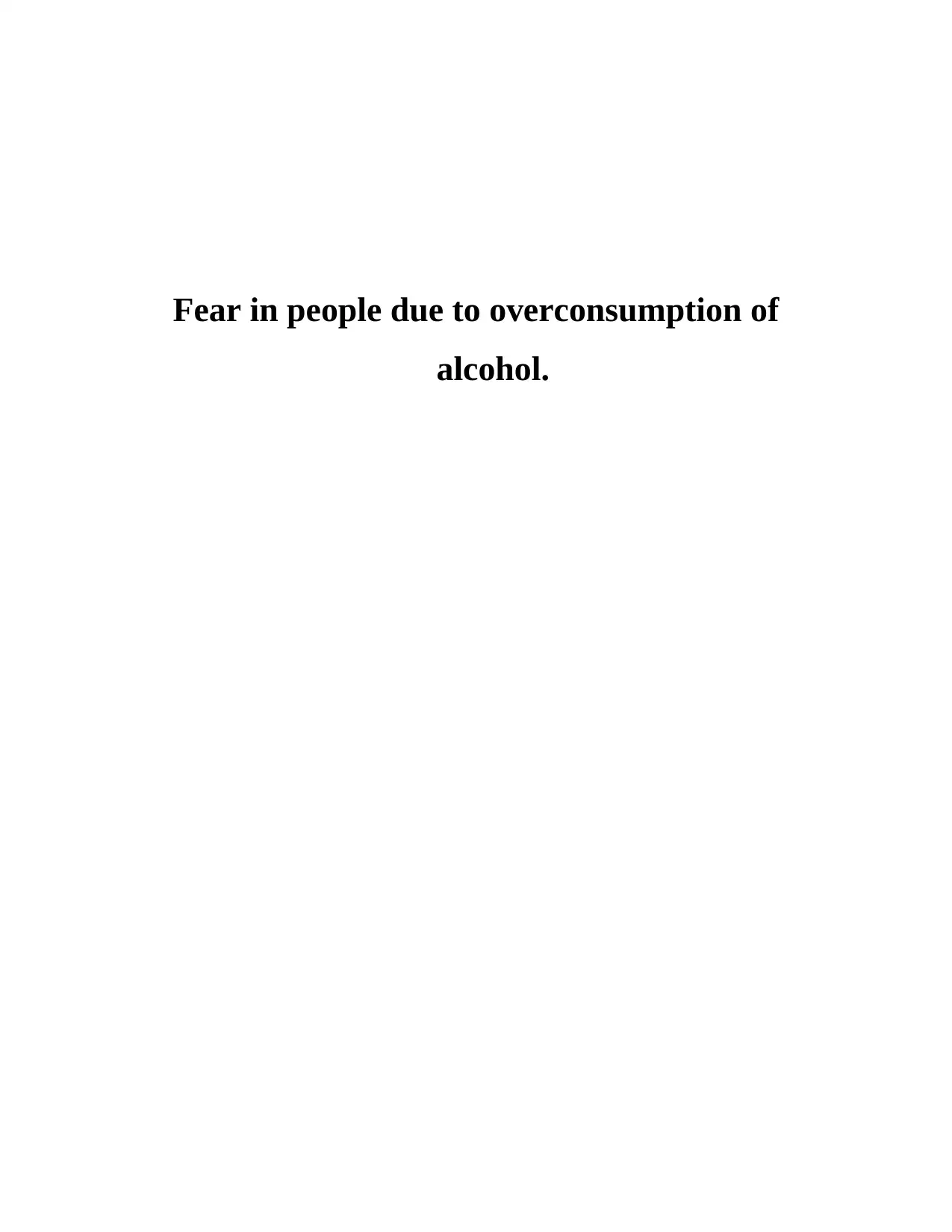
Fear in people due to overconsumption of
alcohol.
alcohol.
Paraphrase This Document
Need a fresh take? Get an instant paraphrase of this document with our AI Paraphraser
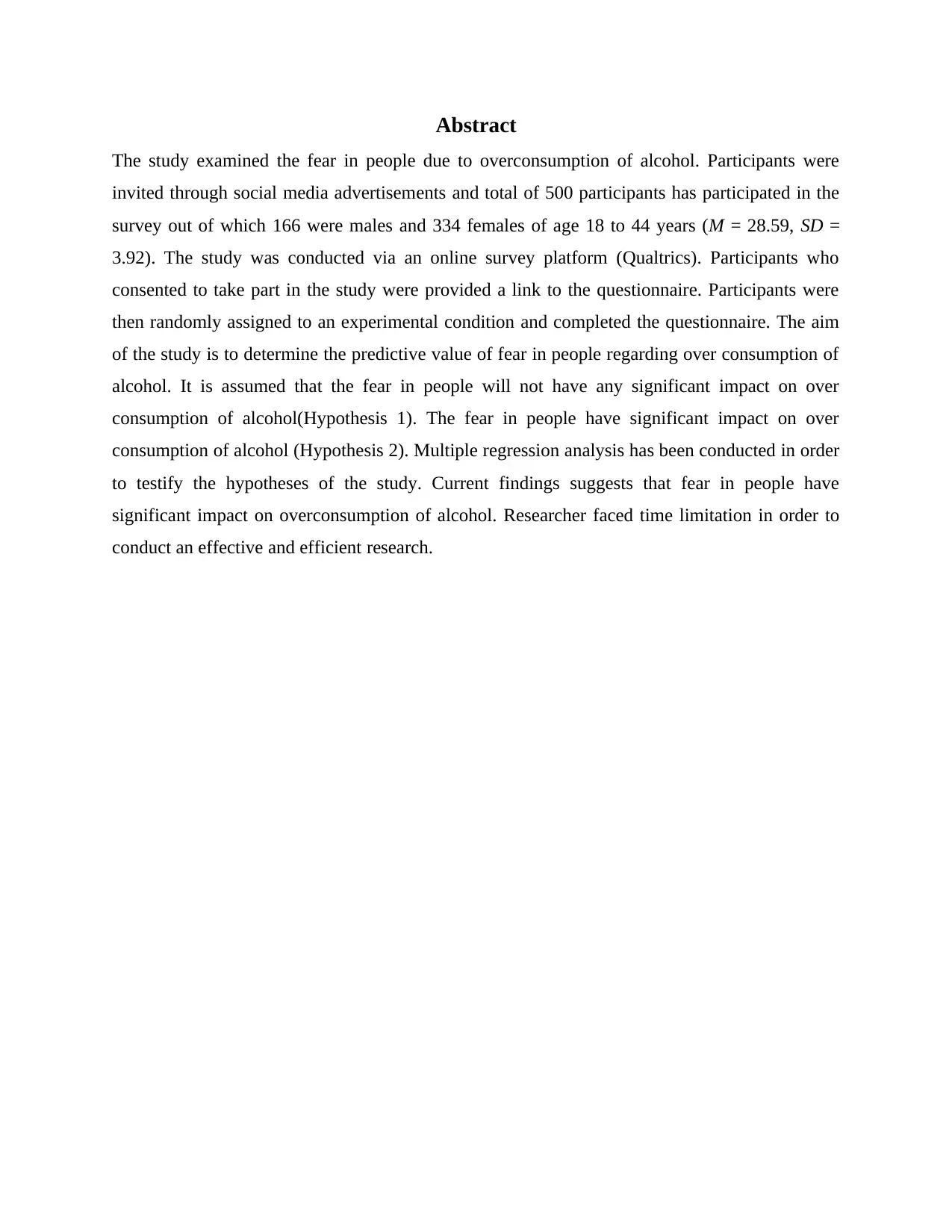
Abstract
The study examined the fear in people due to overconsumption of alcohol. Participants were
invited through social media advertisements and total of 500 participants has participated in the
survey out of which 166 were males and 334 females of age 18 to 44 years (M = 28.59, SD =
3.92). The study was conducted via an online survey platform (Qualtrics). Participants who
consented to take part in the study were provided a link to the questionnaire. Participants were
then randomly assigned to an experimental condition and completed the questionnaire. The aim
of the study is to determine the predictive value of fear in people regarding over consumption of
alcohol. It is assumed that the fear in people will not have any significant impact on over
consumption of alcohol(Hypothesis 1). The fear in people have significant impact on over
consumption of alcohol (Hypothesis 2). Multiple regression analysis has been conducted in order
to testify the hypotheses of the study. Current findings suggests that fear in people have
significant impact on overconsumption of alcohol. Researcher faced time limitation in order to
conduct an effective and efficient research.
The study examined the fear in people due to overconsumption of alcohol. Participants were
invited through social media advertisements and total of 500 participants has participated in the
survey out of which 166 were males and 334 females of age 18 to 44 years (M = 28.59, SD =
3.92). The study was conducted via an online survey platform (Qualtrics). Participants who
consented to take part in the study were provided a link to the questionnaire. Participants were
then randomly assigned to an experimental condition and completed the questionnaire. The aim
of the study is to determine the predictive value of fear in people regarding over consumption of
alcohol. It is assumed that the fear in people will not have any significant impact on over
consumption of alcohol(Hypothesis 1). The fear in people have significant impact on over
consumption of alcohol (Hypothesis 2). Multiple regression analysis has been conducted in order
to testify the hypotheses of the study. Current findings suggests that fear in people have
significant impact on overconsumption of alcohol. Researcher faced time limitation in order to
conduct an effective and efficient research.
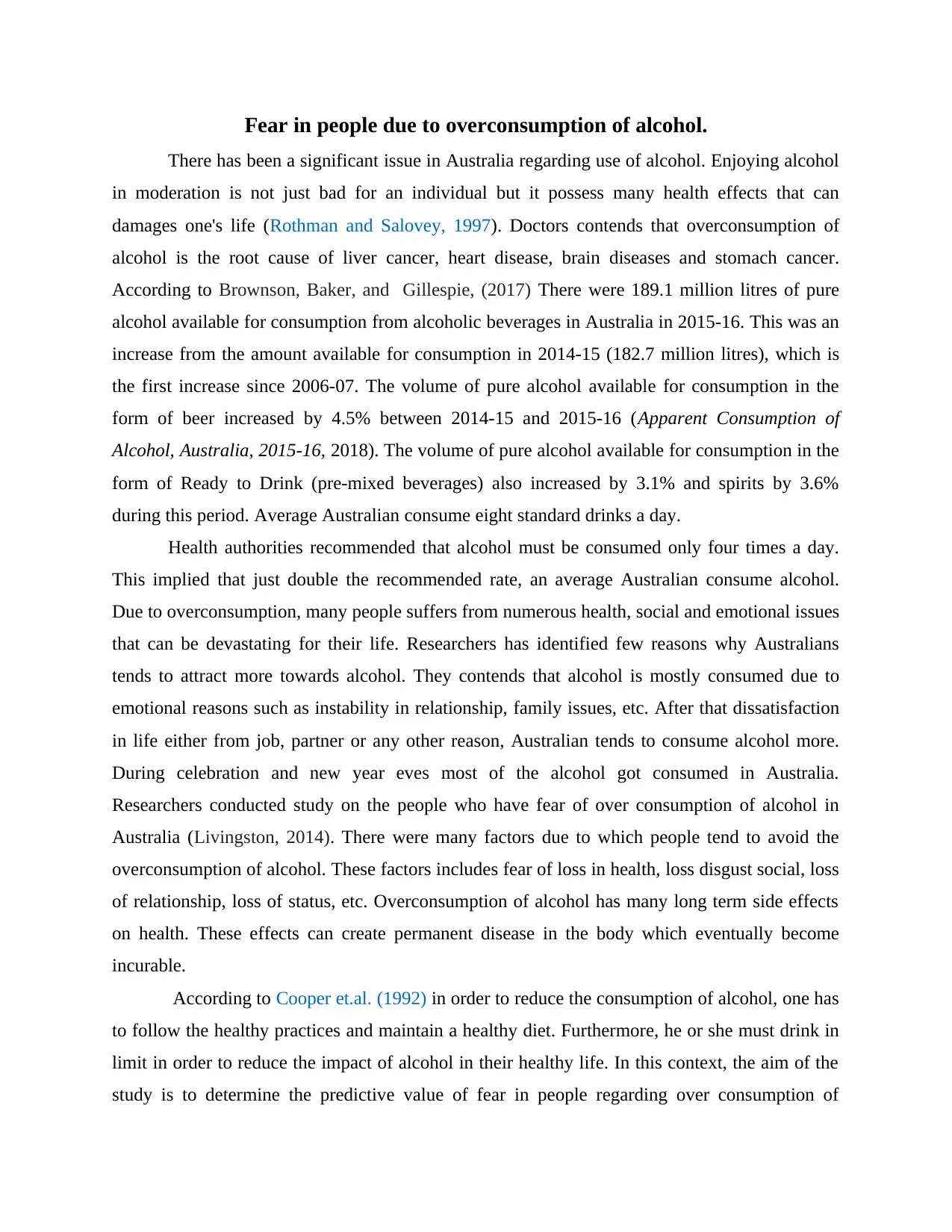
Fear in people due to overconsumption of alcohol.
There has been a significant issue in Australia regarding use of alcohol. Enjoying alcohol
in moderation is not just bad for an individual but it possess many health effects that can
damages one's life (Rothman and Salovey, 1997). Doctors contends that overconsumption of
alcohol is the root cause of liver cancer, heart disease, brain diseases and stomach cancer.
According to Brownson, Baker, and Gillespie, (2017) There were 189.1 million litres of pure
alcohol available for consumption from alcoholic beverages in Australia in 2015-16. This was an
increase from the amount available for consumption in 2014-15 (182.7 million litres), which is
the first increase since 2006-07. The volume of pure alcohol available for consumption in the
form of beer increased by 4.5% between 2014-15 and 2015-16 (Apparent Consumption of
Alcohol, Australia, 2015-16, 2018). The volume of pure alcohol available for consumption in the
form of Ready to Drink (pre-mixed beverages) also increased by 3.1% and spirits by 3.6%
during this period. Average Australian consume eight standard drinks a day.
Health authorities recommended that alcohol must be consumed only four times a day.
This implied that just double the recommended rate, an average Australian consume alcohol.
Due to overconsumption, many people suffers from numerous health, social and emotional issues
that can be devastating for their life. Researchers has identified few reasons why Australians
tends to attract more towards alcohol. They contends that alcohol is mostly consumed due to
emotional reasons such as instability in relationship, family issues, etc. After that dissatisfaction
in life either from job, partner or any other reason, Australian tends to consume alcohol more.
During celebration and new year eves most of the alcohol got consumed in Australia.
Researchers conducted study on the people who have fear of over consumption of alcohol in
Australia (Livingston, 2014). There were many factors due to which people tend to avoid the
overconsumption of alcohol. These factors includes fear of loss in health, loss disgust social, loss
of relationship, loss of status, etc. Overconsumption of alcohol has many long term side effects
on health. These effects can create permanent disease in the body which eventually become
incurable.
According to Cooper et.al. (1992) in order to reduce the consumption of alcohol, one has
to follow the healthy practices and maintain a healthy diet. Furthermore, he or she must drink in
limit in order to reduce the impact of alcohol in their healthy life. In this context, the aim of the
study is to determine the predictive value of fear in people regarding over consumption of
There has been a significant issue in Australia regarding use of alcohol. Enjoying alcohol
in moderation is not just bad for an individual but it possess many health effects that can
damages one's life (Rothman and Salovey, 1997). Doctors contends that overconsumption of
alcohol is the root cause of liver cancer, heart disease, brain diseases and stomach cancer.
According to Brownson, Baker, and Gillespie, (2017) There were 189.1 million litres of pure
alcohol available for consumption from alcoholic beverages in Australia in 2015-16. This was an
increase from the amount available for consumption in 2014-15 (182.7 million litres), which is
the first increase since 2006-07. The volume of pure alcohol available for consumption in the
form of beer increased by 4.5% between 2014-15 and 2015-16 (Apparent Consumption of
Alcohol, Australia, 2015-16, 2018). The volume of pure alcohol available for consumption in the
form of Ready to Drink (pre-mixed beverages) also increased by 3.1% and spirits by 3.6%
during this period. Average Australian consume eight standard drinks a day.
Health authorities recommended that alcohol must be consumed only four times a day.
This implied that just double the recommended rate, an average Australian consume alcohol.
Due to overconsumption, many people suffers from numerous health, social and emotional issues
that can be devastating for their life. Researchers has identified few reasons why Australians
tends to attract more towards alcohol. They contends that alcohol is mostly consumed due to
emotional reasons such as instability in relationship, family issues, etc. After that dissatisfaction
in life either from job, partner or any other reason, Australian tends to consume alcohol more.
During celebration and new year eves most of the alcohol got consumed in Australia.
Researchers conducted study on the people who have fear of over consumption of alcohol in
Australia (Livingston, 2014). There were many factors due to which people tend to avoid the
overconsumption of alcohol. These factors includes fear of loss in health, loss disgust social, loss
of relationship, loss of status, etc. Overconsumption of alcohol has many long term side effects
on health. These effects can create permanent disease in the body which eventually become
incurable.
According to Cooper et.al. (1992) in order to reduce the consumption of alcohol, one has
to follow the healthy practices and maintain a healthy diet. Furthermore, he or she must drink in
limit in order to reduce the impact of alcohol in their healthy life. In this context, the aim of the
study is to determine the predictive value of fear in people regarding over consumption of
⊘ This is a preview!⊘
Do you want full access?
Subscribe today to unlock all pages.

Trusted by 1+ million students worldwide
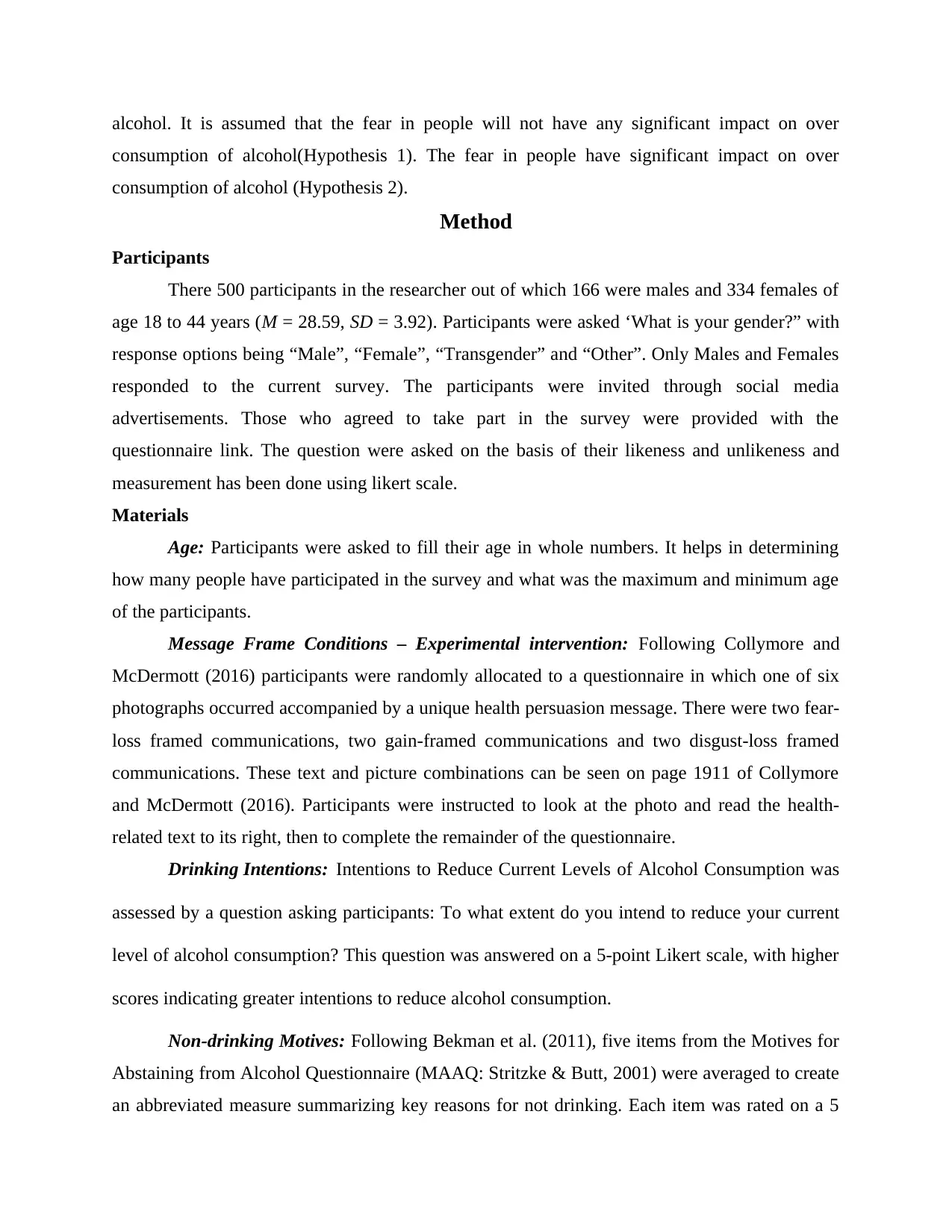
alcohol. It is assumed that the fear in people will not have any significant impact on over
consumption of alcohol(Hypothesis 1). The fear in people have significant impact on over
consumption of alcohol (Hypothesis 2).
Method
Participants
There 500 participants in the researcher out of which 166 were males and 334 females of
age 18 to 44 years (M = 28.59, SD = 3.92). Participants were asked ‘What is your gender?” with
response options being “Male”, “Female”, “Transgender” and “Other”. Only Males and Females
responded to the current survey. The participants were invited through social media
advertisements. Those who agreed to take part in the survey were provided with the
questionnaire link. The question were asked on the basis of their likeness and unlikeness and
measurement has been done using likert scale.
Materials
Age: Participants were asked to fill their age in whole numbers. It helps in determining
how many people have participated in the survey and what was the maximum and minimum age
of the participants.
Message Frame Conditions – Experimental intervention: Following Collymore and
McDermott (2016) participants were randomly allocated to a questionnaire in which one of six
photographs occurred accompanied by a unique health persuasion message. There were two fear-
loss framed communications, two gain-framed communications and two disgust-loss framed
communications. These text and picture combinations can be seen on page 1911 of Collymore
and McDermott (2016). Participants were instructed to look at the photo and read the health-
related text to its right, then to complete the remainder of the questionnaire.
Drinking Intentions: Intentions to Reduce Current Levels of Alcohol Consumption was
assessed by a question asking participants: To what extent do you intend to reduce your current
level of alcohol consumption? This question was answered on a 5-point Likert scale, with higher
scores indicating greater intentions to reduce alcohol consumption.
Non-drinking Motives: Following Bekman et al. (2011), five items from the Motives for
Abstaining from Alcohol Questionnaire (MAAQ: Stritzke & Butt, 2001) were averaged to create
an abbreviated measure summarizing key reasons for not drinking. Each item was rated on a 5
consumption of alcohol(Hypothesis 1). The fear in people have significant impact on over
consumption of alcohol (Hypothesis 2).
Method
Participants
There 500 participants in the researcher out of which 166 were males and 334 females of
age 18 to 44 years (M = 28.59, SD = 3.92). Participants were asked ‘What is your gender?” with
response options being “Male”, “Female”, “Transgender” and “Other”. Only Males and Females
responded to the current survey. The participants were invited through social media
advertisements. Those who agreed to take part in the survey were provided with the
questionnaire link. The question were asked on the basis of their likeness and unlikeness and
measurement has been done using likert scale.
Materials
Age: Participants were asked to fill their age in whole numbers. It helps in determining
how many people have participated in the survey and what was the maximum and minimum age
of the participants.
Message Frame Conditions – Experimental intervention: Following Collymore and
McDermott (2016) participants were randomly allocated to a questionnaire in which one of six
photographs occurred accompanied by a unique health persuasion message. There were two fear-
loss framed communications, two gain-framed communications and two disgust-loss framed
communications. These text and picture combinations can be seen on page 1911 of Collymore
and McDermott (2016). Participants were instructed to look at the photo and read the health-
related text to its right, then to complete the remainder of the questionnaire.
Drinking Intentions: Intentions to Reduce Current Levels of Alcohol Consumption was
assessed by a question asking participants: To what extent do you intend to reduce your current
level of alcohol consumption? This question was answered on a 5-point Likert scale, with higher
scores indicating greater intentions to reduce alcohol consumption.
Non-drinking Motives: Following Bekman et al. (2011), five items from the Motives for
Abstaining from Alcohol Questionnaire (MAAQ: Stritzke & Butt, 2001) were averaged to create
an abbreviated measure summarizing key reasons for not drinking. Each item was rated on a 5
Paraphrase This Document
Need a fresh take? Get an instant paraphrase of this document with our AI Paraphraser
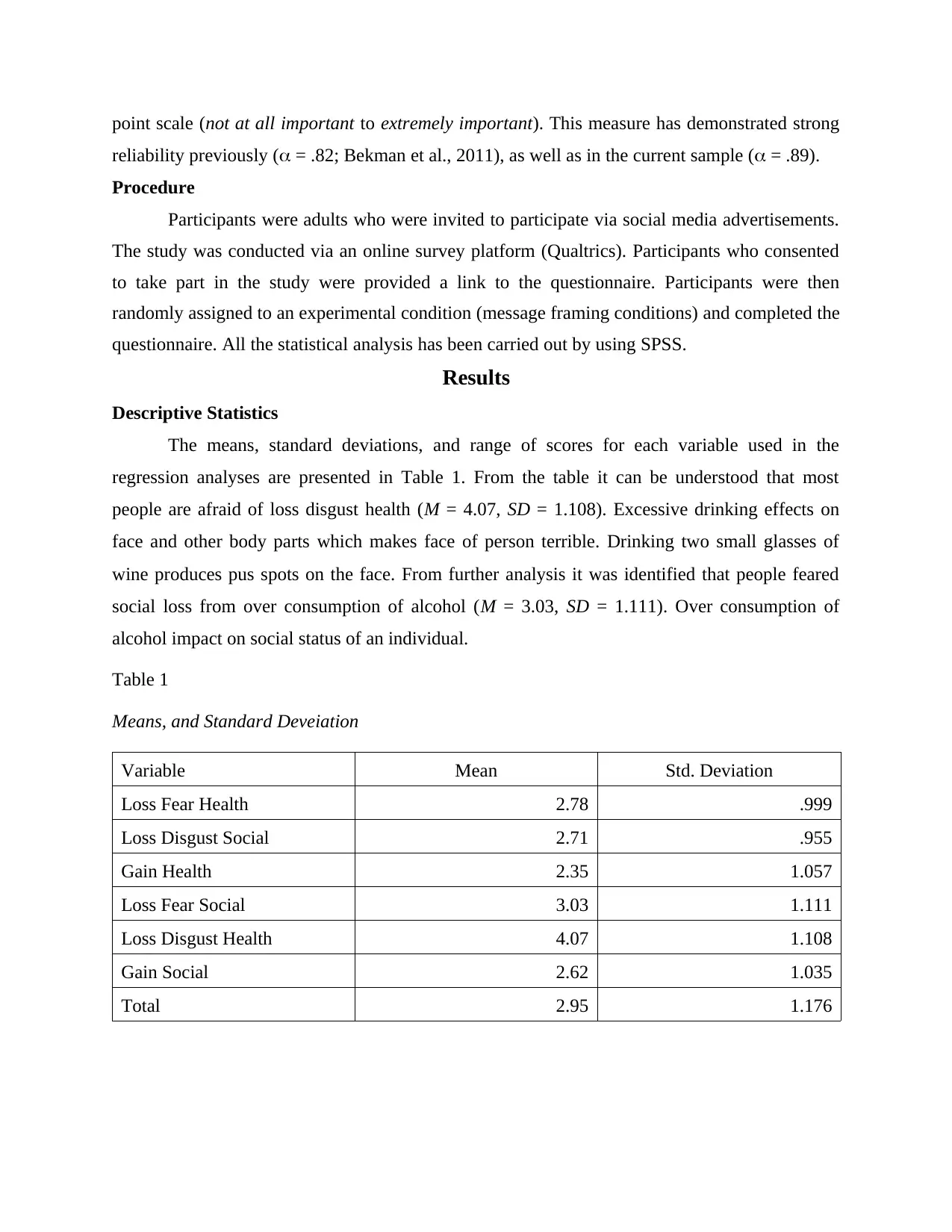
point scale (not at all important to extremely important). This measure has demonstrated strong
reliability previously ( = .82; Bekman et al., 2011), as well as in the current sample ( = .89).
Procedure
Participants were adults who were invited to participate via social media advertisements.
The study was conducted via an online survey platform (Qualtrics). Participants who consented
to take part in the study were provided a link to the questionnaire. Participants were then
randomly assigned to an experimental condition (message framing conditions) and completed the
questionnaire. All the statistical analysis has been carried out by using SPSS.
Results
Descriptive Statistics
The means, standard deviations, and range of scores for each variable used in the
regression analyses are presented in Table 1. From the table it can be understood that most
people are afraid of loss disgust health (M = 4.07, SD = 1.108). Excessive drinking effects on
face and other body parts which makes face of person terrible. Drinking two small glasses of
wine produces pus spots on the face. From further analysis it was identified that people feared
social loss from over consumption of alcohol (M = 3.03, SD = 1.111). Over consumption of
alcohol impact on social status of an individual.
Table 1
Means, and Standard Deveiation
Variable Mean Std. Deviation
Loss Fear Health 2.78 .999
Loss Disgust Social 2.71 .955
Gain Health 2.35 1.057
Loss Fear Social 3.03 1.111
Loss Disgust Health 4.07 1.108
Gain Social 2.62 1.035
Total 2.95 1.176
reliability previously ( = .82; Bekman et al., 2011), as well as in the current sample ( = .89).
Procedure
Participants were adults who were invited to participate via social media advertisements.
The study was conducted via an online survey platform (Qualtrics). Participants who consented
to take part in the study were provided a link to the questionnaire. Participants were then
randomly assigned to an experimental condition (message framing conditions) and completed the
questionnaire. All the statistical analysis has been carried out by using SPSS.
Results
Descriptive Statistics
The means, standard deviations, and range of scores for each variable used in the
regression analyses are presented in Table 1. From the table it can be understood that most
people are afraid of loss disgust health (M = 4.07, SD = 1.108). Excessive drinking effects on
face and other body parts which makes face of person terrible. Drinking two small glasses of
wine produces pus spots on the face. From further analysis it was identified that people feared
social loss from over consumption of alcohol (M = 3.03, SD = 1.111). Over consumption of
alcohol impact on social status of an individual.
Table 1
Means, and Standard Deveiation
Variable Mean Std. Deviation
Loss Fear Health 2.78 .999
Loss Disgust Social 2.71 .955
Gain Health 2.35 1.057
Loss Fear Social 3.03 1.111
Loss Disgust Health 4.07 1.108
Gain Social 2.62 1.035
Total 2.95 1.176
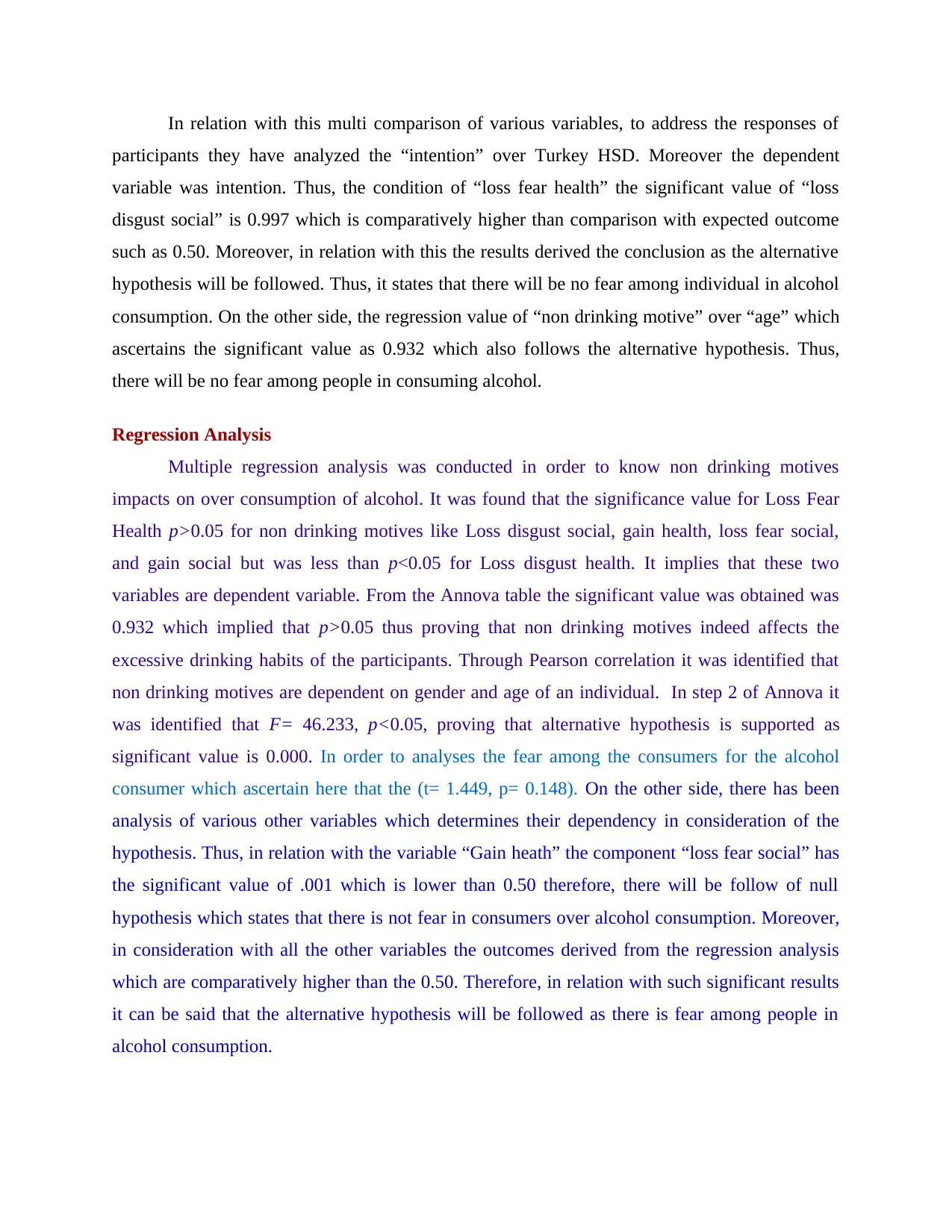
In relation with this multi comparison of various variables, to address the responses of
participants they have analyzed the “intention” over Turkey HSD. Moreover the dependent
variable was intention. Thus, the condition of “loss fear health” the significant value of “loss
disgust social” is 0.997 which is comparatively higher than comparison with expected outcome
such as 0.50. Moreover, in relation with this the results derived the conclusion as the alternative
hypothesis will be followed. Thus, it states that there will be no fear among individual in alcohol
consumption. On the other side, the regression value of “non drinking motive” over “age” which
ascertains the significant value as 0.932 which also follows the alternative hypothesis. Thus,
there will be no fear among people in consuming alcohol.
Regression Analysis
Multiple regression analysis was conducted in order to know non drinking motives
impacts on over consumption of alcohol. It was found that the significance value for Loss Fear
Health p>0.05 for non drinking motives like Loss disgust social, gain health, loss fear social,
and gain social but was less than p<0.05 for Loss disgust health. It implies that these two
variables are dependent variable. From the Annova table the significant value was obtained was
0.932 which implied that p>0.05 thus proving that non drinking motives indeed affects the
excessive drinking habits of the participants. Through Pearson correlation it was identified that
non drinking motives are dependent on gender and age of an individual. In step 2 of Annova it
was identified that F= 46.233, p<0.05, proving that alternative hypothesis is supported as
significant value is 0.000. In order to analyses the fear among the consumers for the alcohol
consumer which ascertain here that the (t= 1.449, p= 0.148). On the other side, there has been
analysis of various other variables which determines their dependency in consideration of the
hypothesis. Thus, in relation with the variable “Gain heath” the component “loss fear social” has
the significant value of .001 which is lower than 0.50 therefore, there will be follow of null
hypothesis which states that there is not fear in consumers over alcohol consumption. Moreover,
in consideration with all the other variables the outcomes derived from the regression analysis
which are comparatively higher than the 0.50. Therefore, in relation with such significant results
it can be said that the alternative hypothesis will be followed as there is fear among people in
alcohol consumption.
participants they have analyzed the “intention” over Turkey HSD. Moreover the dependent
variable was intention. Thus, the condition of “loss fear health” the significant value of “loss
disgust social” is 0.997 which is comparatively higher than comparison with expected outcome
such as 0.50. Moreover, in relation with this the results derived the conclusion as the alternative
hypothesis will be followed. Thus, it states that there will be no fear among individual in alcohol
consumption. On the other side, the regression value of “non drinking motive” over “age” which
ascertains the significant value as 0.932 which also follows the alternative hypothesis. Thus,
there will be no fear among people in consuming alcohol.
Regression Analysis
Multiple regression analysis was conducted in order to know non drinking motives
impacts on over consumption of alcohol. It was found that the significance value for Loss Fear
Health p>0.05 for non drinking motives like Loss disgust social, gain health, loss fear social,
and gain social but was less than p<0.05 for Loss disgust health. It implies that these two
variables are dependent variable. From the Annova table the significant value was obtained was
0.932 which implied that p>0.05 thus proving that non drinking motives indeed affects the
excessive drinking habits of the participants. Through Pearson correlation it was identified that
non drinking motives are dependent on gender and age of an individual. In step 2 of Annova it
was identified that F= 46.233, p<0.05, proving that alternative hypothesis is supported as
significant value is 0.000. In order to analyses the fear among the consumers for the alcohol
consumer which ascertain here that the (t= 1.449, p= 0.148). On the other side, there has been
analysis of various other variables which determines their dependency in consideration of the
hypothesis. Thus, in relation with the variable “Gain heath” the component “loss fear social” has
the significant value of .001 which is lower than 0.50 therefore, there will be follow of null
hypothesis which states that there is not fear in consumers over alcohol consumption. Moreover,
in consideration with all the other variables the outcomes derived from the regression analysis
which are comparatively higher than the 0.50. Therefore, in relation with such significant results
it can be said that the alternative hypothesis will be followed as there is fear among people in
alcohol consumption.
⊘ This is a preview!⊘
Do you want full access?
Subscribe today to unlock all pages.

Trusted by 1+ million students worldwide
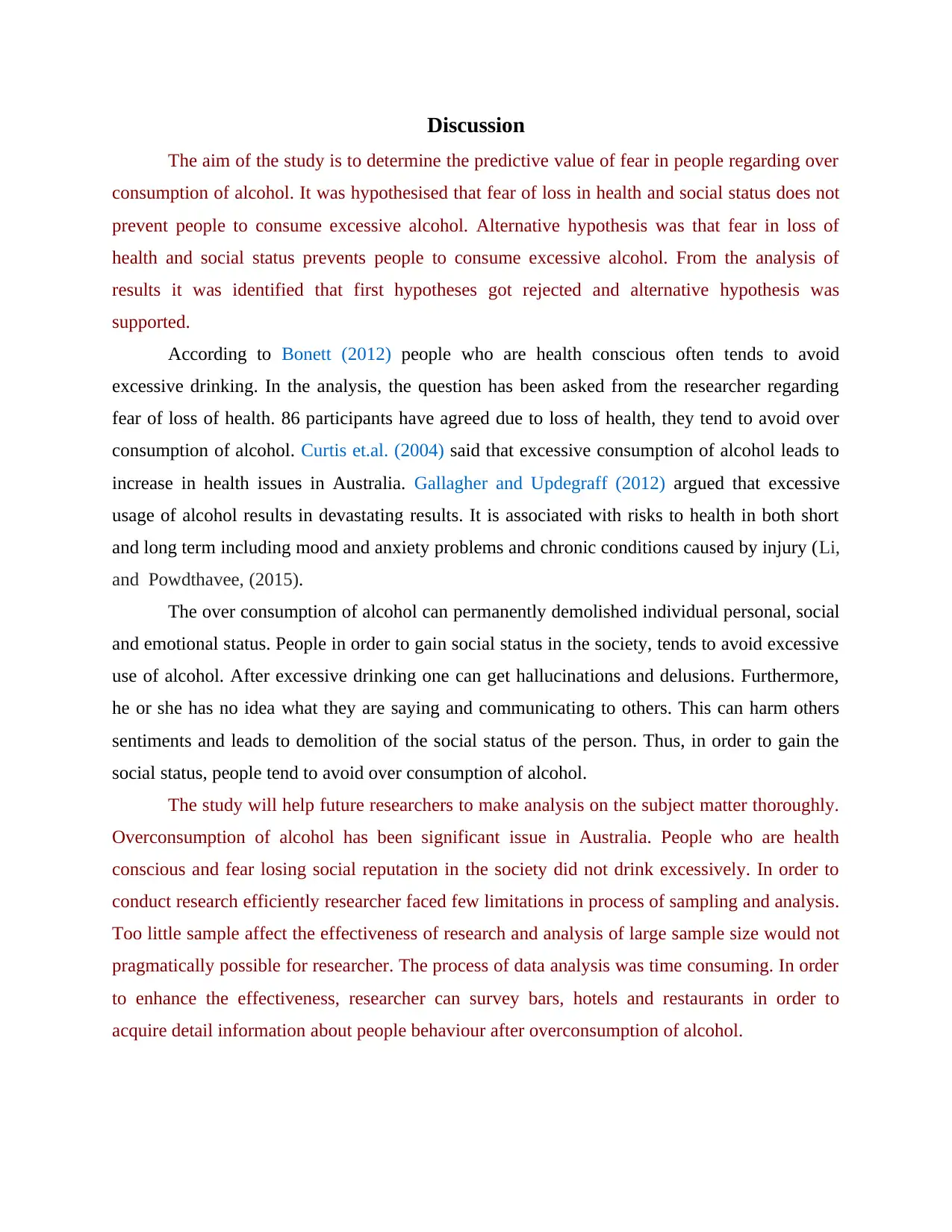
Discussion
The aim of the study is to determine the predictive value of fear in people regarding over
consumption of alcohol. It was hypothesised that fear of loss in health and social status does not
prevent people to consume excessive alcohol. Alternative hypothesis was that fear in loss of
health and social status prevents people to consume excessive alcohol. From the analysis of
results it was identified that first hypotheses got rejected and alternative hypothesis was
supported.
According to Bonett (2012) people who are health conscious often tends to avoid
excessive drinking. In the analysis, the question has been asked from the researcher regarding
fear of loss of health. 86 participants have agreed due to loss of health, they tend to avoid over
consumption of alcohol. Curtis et.al. (2004) said that excessive consumption of alcohol leads to
increase in health issues in Australia. Gallagher and Updegraff (2012) argued that excessive
usage of alcohol results in devastating results. It is associated with risks to health in both short
and long term including mood and anxiety problems and chronic conditions caused by injury (Li,
and Powdthavee, (2015).
The over consumption of alcohol can permanently demolished individual personal, social
and emotional status. People in order to gain social status in the society, tends to avoid excessive
use of alcohol. After excessive drinking one can get hallucinations and delusions. Furthermore,
he or she has no idea what they are saying and communicating to others. This can harm others
sentiments and leads to demolition of the social status of the person. Thus, in order to gain the
social status, people tend to avoid over consumption of alcohol.
The study will help future researchers to make analysis on the subject matter thoroughly.
Overconsumption of alcohol has been significant issue in Australia. People who are health
conscious and fear losing social reputation in the society did not drink excessively. In order to
conduct research efficiently researcher faced few limitations in process of sampling and analysis.
Too little sample affect the effectiveness of research and analysis of large sample size would not
pragmatically possible for researcher. The process of data analysis was time consuming. In order
to enhance the effectiveness, researcher can survey bars, hotels and restaurants in order to
acquire detail information about people behaviour after overconsumption of alcohol.
The aim of the study is to determine the predictive value of fear in people regarding over
consumption of alcohol. It was hypothesised that fear of loss in health and social status does not
prevent people to consume excessive alcohol. Alternative hypothesis was that fear in loss of
health and social status prevents people to consume excessive alcohol. From the analysis of
results it was identified that first hypotheses got rejected and alternative hypothesis was
supported.
According to Bonett (2012) people who are health conscious often tends to avoid
excessive drinking. In the analysis, the question has been asked from the researcher regarding
fear of loss of health. 86 participants have agreed due to loss of health, they tend to avoid over
consumption of alcohol. Curtis et.al. (2004) said that excessive consumption of alcohol leads to
increase in health issues in Australia. Gallagher and Updegraff (2012) argued that excessive
usage of alcohol results in devastating results. It is associated with risks to health in both short
and long term including mood and anxiety problems and chronic conditions caused by injury (Li,
and Powdthavee, (2015).
The over consumption of alcohol can permanently demolished individual personal, social
and emotional status. People in order to gain social status in the society, tends to avoid excessive
use of alcohol. After excessive drinking one can get hallucinations and delusions. Furthermore,
he or she has no idea what they are saying and communicating to others. This can harm others
sentiments and leads to demolition of the social status of the person. Thus, in order to gain the
social status, people tend to avoid over consumption of alcohol.
The study will help future researchers to make analysis on the subject matter thoroughly.
Overconsumption of alcohol has been significant issue in Australia. People who are health
conscious and fear losing social reputation in the society did not drink excessively. In order to
conduct research efficiently researcher faced few limitations in process of sampling and analysis.
Too little sample affect the effectiveness of research and analysis of large sample size would not
pragmatically possible for researcher. The process of data analysis was time consuming. In order
to enhance the effectiveness, researcher can survey bars, hotels and restaurants in order to
acquire detail information about people behaviour after overconsumption of alcohol.
Paraphrase This Document
Need a fresh take? Get an instant paraphrase of this document with our AI Paraphraser
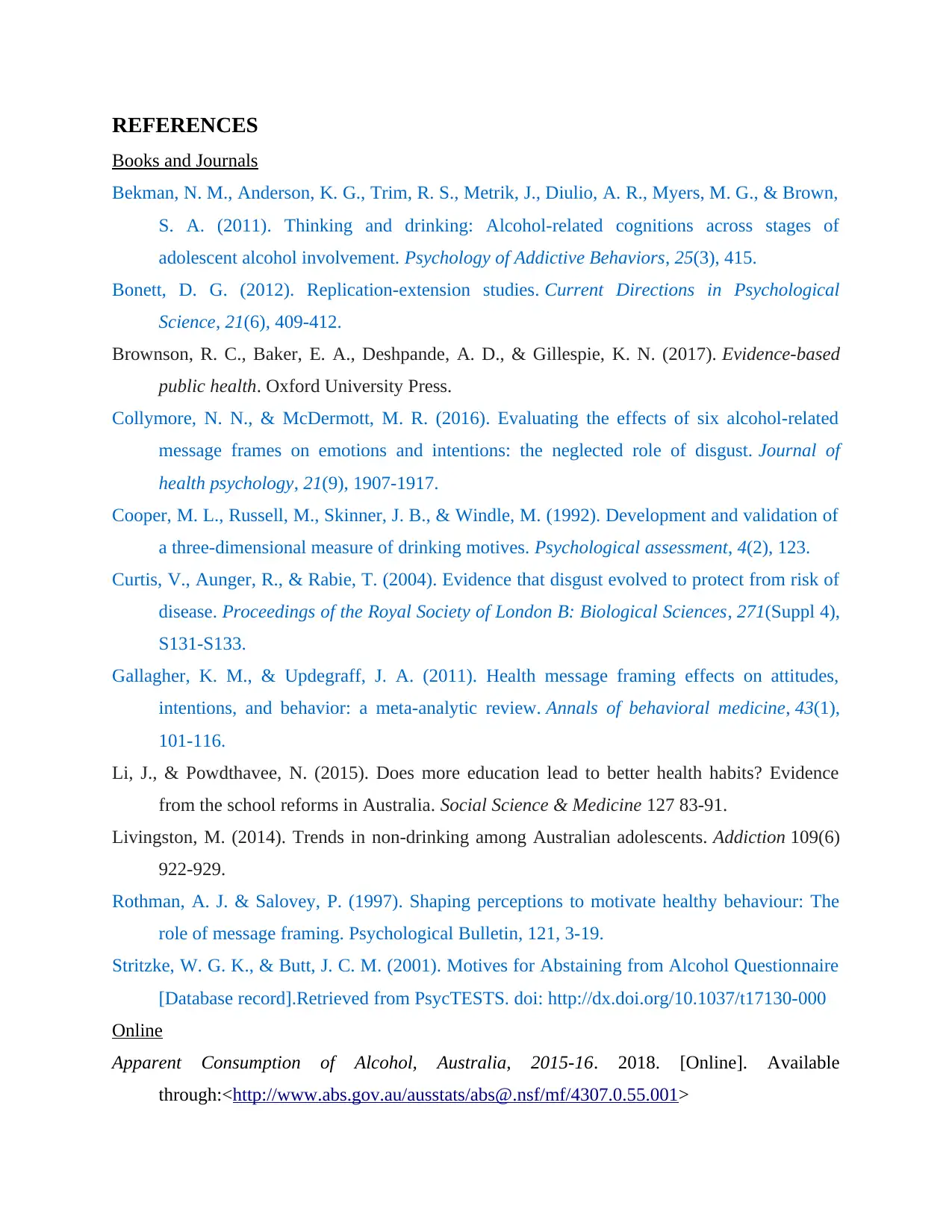
REFERENCES
Books and Journals
Bekman, N. M., Anderson, K. G., Trim, R. S., Metrik, J., Diulio, A. R., Myers, M. G., & Brown,
S. A. (2011). Thinking and drinking: Alcohol-related cognitions across stages of
adolescent alcohol involvement. Psychology of Addictive Behaviors, 25(3), 415.
Bonett, D. G. (2012). Replication-extension studies. Current Directions in Psychological
Science, 21(6), 409-412.
Brownson, R. C., Baker, E. A., Deshpande, A. D., & Gillespie, K. N. (2017). Evidence-based
public health. Oxford University Press.
Collymore, N. N., & McDermott, M. R. (2016). Evaluating the effects of six alcohol-related
message frames on emotions and intentions: the neglected role of disgust. Journal of
health psychology, 21(9), 1907-1917.
Cooper, M. L., Russell, M., Skinner, J. B., & Windle, M. (1992). Development and validation of
a three-dimensional measure of drinking motives. Psychological assessment, 4(2), 123.
Curtis, V., Aunger, R., & Rabie, T. (2004). Evidence that disgust evolved to protect from risk of
disease. Proceedings of the Royal Society of London B: Biological Sciences, 271(Suppl 4),
S131-S133.
Gallagher, K. M., & Updegraff, J. A. (2011). Health message framing effects on attitudes,
intentions, and behavior: a meta-analytic review. Annals of behavioral medicine, 43(1),
101-116.
Li, J., & Powdthavee, N. (2015). Does more education lead to better health habits? Evidence
from the school reforms in Australia. Social Science & Medicine 127 83-91.
Livingston, M. (2014). Trends in non‐drinking among Australian adolescents. Addiction 109(6)
922-929.
Rothman, A. J. & Salovey, P. (1997). Shaping perceptions to motivate healthy behaviour: The
role of message framing. Psychological Bulletin, 121, 3-19.
Stritzke, W. G. K., & Butt, J. C. M. (2001). Motives for Abstaining from Alcohol Questionnaire
[Database record].Retrieved from PsycTESTS. doi: http://dx.doi.org/10.1037/t17130-000
Online
Apparent Consumption of Alcohol, Australia, 2015-16. 2018. [Online]. Available
through:<http://www.abs.gov.au/ausstats/abs@.nsf/mf/4307.0.55.001>
Books and Journals
Bekman, N. M., Anderson, K. G., Trim, R. S., Metrik, J., Diulio, A. R., Myers, M. G., & Brown,
S. A. (2011). Thinking and drinking: Alcohol-related cognitions across stages of
adolescent alcohol involvement. Psychology of Addictive Behaviors, 25(3), 415.
Bonett, D. G. (2012). Replication-extension studies. Current Directions in Psychological
Science, 21(6), 409-412.
Brownson, R. C., Baker, E. A., Deshpande, A. D., & Gillespie, K. N. (2017). Evidence-based
public health. Oxford University Press.
Collymore, N. N., & McDermott, M. R. (2016). Evaluating the effects of six alcohol-related
message frames on emotions and intentions: the neglected role of disgust. Journal of
health psychology, 21(9), 1907-1917.
Cooper, M. L., Russell, M., Skinner, J. B., & Windle, M. (1992). Development and validation of
a three-dimensional measure of drinking motives. Psychological assessment, 4(2), 123.
Curtis, V., Aunger, R., & Rabie, T. (2004). Evidence that disgust evolved to protect from risk of
disease. Proceedings of the Royal Society of London B: Biological Sciences, 271(Suppl 4),
S131-S133.
Gallagher, K. M., & Updegraff, J. A. (2011). Health message framing effects on attitudes,
intentions, and behavior: a meta-analytic review. Annals of behavioral medicine, 43(1),
101-116.
Li, J., & Powdthavee, N. (2015). Does more education lead to better health habits? Evidence
from the school reforms in Australia. Social Science & Medicine 127 83-91.
Livingston, M. (2014). Trends in non‐drinking among Australian adolescents. Addiction 109(6)
922-929.
Rothman, A. J. & Salovey, P. (1997). Shaping perceptions to motivate healthy behaviour: The
role of message framing. Psychological Bulletin, 121, 3-19.
Stritzke, W. G. K., & Butt, J. C. M. (2001). Motives for Abstaining from Alcohol Questionnaire
[Database record].Retrieved from PsycTESTS. doi: http://dx.doi.org/10.1037/t17130-000
Online
Apparent Consumption of Alcohol, Australia, 2015-16. 2018. [Online]. Available
through:<http://www.abs.gov.au/ausstats/abs@.nsf/mf/4307.0.55.001>

⊘ This is a preview!⊘
Do you want full access?
Subscribe today to unlock all pages.

Trusted by 1+ million students worldwide
1 out of 9
Related Documents
Your All-in-One AI-Powered Toolkit for Academic Success.
+13062052269
info@desklib.com
Available 24*7 on WhatsApp / Email
![[object Object]](/_next/static/media/star-bottom.7253800d.svg)
Unlock your academic potential
Copyright © 2020–2025 A2Z Services. All Rights Reserved. Developed and managed by ZUCOL.





